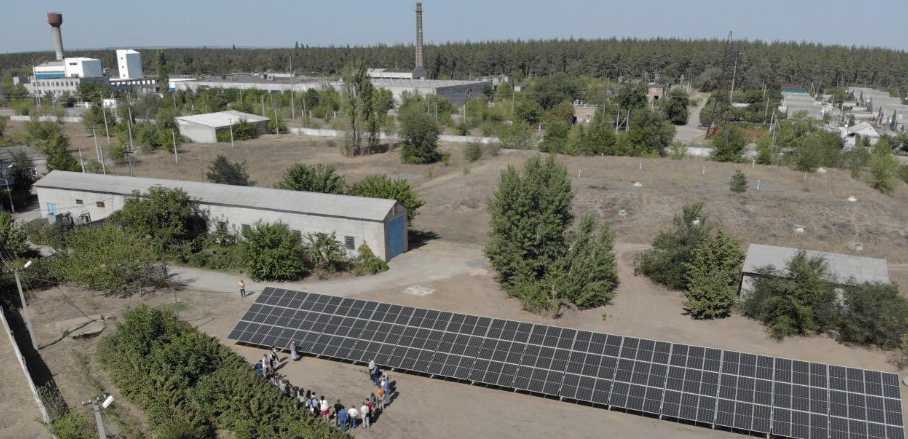Let the Sun Shine on Ukraine – How Solar Power Accelerates the Green Reconstruction of Cities
Solar energy solutions need to be scaled up to address electricity shortages in both emergency and mid-term responses to the crisis in Ukraine. Vladlena Martsynkevych is convinced: Ukraine is ready for a better, greener future.
Russian attacks are destroying Ukraine’s energy infrastructure and leaving millions of people freezing in the middle of winter. The provision of diesel, oil, and gas generators is a critical but short-term and patchy solution. Thinking a step ahead, supplying solar energy equipment and financial support to scale up renewable energy production in Ukrainian communities and cities would provide a resilient source of energy from spring 2023 and for years to come.
Russia is using the cold and dark winter to break Ukrainians’ resolve to fight for their nation’s independence and sovereignty. As temperatures plummet below zero, attacks against civilian targets and Ukraine’s energy infrastructure have left millions without stable access to electricity, water, and heating.
Fossil Fuels – Emergency Solutions for Survival
In response to the electricity shortages, the Ukrainian government and its international partners have focused their efforts on finding emergency solutions for survival. The blackouts pose a major threat to the lives of the vulnerable by disrupting the operation of hospitals and all medical facilities, including special care. Thus, deliveries of diesel, petrol, and gas generators for critical facilities or public ‘points of resilience’ where people receive basic services – such as phone charging, WiFi connection, heating, and lighting – and as a backup are vital.
Fossil fuel generators have become a suitable quick fix. However, they are not sustainable – neither from a long-term perspective nor on a broader scale. The generators have high running costs and depend on the availability of fuel. Certain favourable conditions like tax exemptions for imports and simplified procurement were introduced to make it easier to purchase generators and keep the country running. Currently, the demand for generators for industrial capacities remains high.
According to Ukrenergo, the country’s energy utility company, it might take as long as two years to fully restore a stable electricity supply to communities and cities. The massive supply and installation of generators are slowing the transition to sustainable, resilient, greener, and longer-term solutions. Therefore, experts and civil society organisations are calling for diverse and alternative solutions such as renewable sources, particularly solar electricity.
Keeping up with Global Climate Targets
Small-scale photovoltaic solar energy generation of up to 1 megawatt (MW) accounts for the largest chunk of installed capacity among renewable technologies in Ukraine. However, the total installed capacity and solar production are still very low in comparison to fossil-based energy sources. Renewable energy needs to be scaled up to support Ukrainians and keep up with global climate targets and EU ‘renewable energy community’ initiatives. Recent opinion polls demonstrate overall support within the population for renewables as a reliable solution for energy supply and cost efficiency.
In spring 2023, solar energy systems with storage will become increasingly necessary. Solar photovoltaic stations also work during the winter, albeit with significantly lower electricity generation due to less sunlight and more clouds. Even so, energy generated and stored in batteries can still be used to power people’s basic needs and enable institutions to provide services like communication, internet access, administration, and lighting. Photovoltaic stations would allow for a high level of energy autonomy and resilience for Ukrainian communities, who are currently dealing with an avalanche of challenges all at once.
The good news: such renewable energy-based systems are already being installed across Ukraine. For example, the solar power plant at the Mariina Roshcha water pumping station in the city of Voznesensk in the Mykolaiv region was implemented thanks to joint efforts by the municipality, water enterprise and a non-governmental organisation called Ecoclub.

Solar station in Voznesensk (Southern Ukraine) © Ecoclub
Installed solar capacity, costs, and savings of the Mariina Roscha photovoltaic facility:
- investment: UAH 1.18 million (EUR 30,000) invested
- installed capacity: 50 kilowatts (kW) with plans which expand the capacity to 200 kW
- electricity generation: 50-70 megawatt hours (MWh) per year, covering up to 15 per cent of the water pumping station’s needs.
- estimated cost savings in 2022: UAH 159,641 (EUR 4,100)
- yearly reductions in greenhouse gas emissions: 25,200 kilograms (kg) of carbon dioxide or equivalent
Strengthening Resilience and Inclusivity
Solar projects guarantee multiple benefits for both municipalities and Ukrainians in general. The combination of solar power generation and storage provides electricity in situations when the power grid is unavailable because of military damage. These capacities enable at least partial access to electricity and all the services it provides, such as communications, heating, and street lighting, even during autumn and winter. Moreover, solar energy projects allow consumers and enterprises to lower their energy bills while providing jobs and other benefits to the local economy. Additionally, local energy generation is a key step towards building a decentralised and smart energy grid, which will be more just, inclusive, and resilient than the current one. Finally, solar energy – alongside other renewable sources – is widely recognised as one of the most effective ways to lower carbon emissions and help local communities adapt to climate change.
Ukraine is Ready for the Future
Ukraine has a feed-in energy system, including for small solar projects. Solar stations combined with battery storage solutions, which were initially designed and optimised to cover the energy needs of households, are becoming especially important now.
In response to unstable electricity production from the central grid, Ukrainians are already introducing power storage and stabilisation equipment to their homes and public spaces. In most cases, such systems consisting of batteries and inverters are already prepared for and will simplify the introduction of decentralised solar electricity production.
